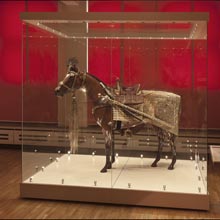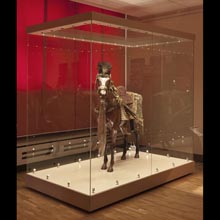

description:
Saddle with underlay, shabraque and pockets
Ottoman, mid- 17th century
by the saddle:
Sabre karabela
Ottoman, 2nd half of the 17th century
Gift of Erazm Barącz, 1922
Estoc
Ottoman, 17th century
From the former collection of the Moszyński family
Stirrups
Ottoman, mid- 17th century
elements of caparison:
Head-stall
Ottoman, mid- 17th century
Martingale
Ottoman, mid- 17th century
Crupper
Ottoman, mid- 17th century
Decorative horse-tail mounted under the throat
Ottoman, mid- 17th century
exposition: Gallery „Arms and Uniforms in Poland",
The Main Building, 1, 3 Maja Av.
key: Saddles and riding equipment <<<
Piotr Wilkosz
Saddle with underlay, shabraque and pockets
Ottoman, mid- 17th century
by the saddle:
Sabre karabela
Ottoman, 2nd half of the 17th century
Gift of Erazm Barącz, 1922
Estoc
Ottoman, 17th century
From the former collection of the Moszyński family
Stirrups
Ottoman, mid- 17th century
elements of caparison:
Head-stall
Ottoman, mid- 17th century
Martingale
Ottoman, mid- 17th century
Crupper
Ottoman, mid- 17th century
Decorative horse-tail mounted under the throat
Ottoman, mid- 17th century
exposition: Gallery „Arms and Uniforms in Poland",
The Main Building, 1, 3 Maja Av.
key: Saddles and riding equipment <<<
The collection of saddles and riding gear, both from Europe and the East, includes tacks, curbs and bradoons, stirrups, horseshoes, and spurs. Particularly valuable are the Polish and Turkish saddles and tacks, with their unique horse tack of turkish manufacture form the second half of the seventeenth century, which belonged to Hetman Stefan Czarniecki. Also richly ornamented tacks are the horse tacks made by Lwów Armenians in the seventeenth and eighteenth centuries from the Cielecki, Tarnowski, and Jabłonowski families.
Piotr Wilkosz












